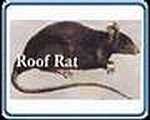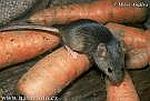Rodents
 Norway and Roof Rats
Norway and Roof Rats
Rats are some of the most troublesome and damaging rodents in the United States. They consume and contaminate food, damage structures and property, and transmit parasites and diseases to other animals and humans. Rats live and thrive under a wide variety of climates and conditions; they are often found in and around homes and other buildings, farms, gardens, and open fields. People do not often see rats, but signs of their presence are easy to detect. In California, the most troublesome rats are two introduced species: the roof rat and the Norway rat. It is important to know which species of rat is present in order to place traps or baits in the most effective locations. Norway rats (Rattus norvegicus), sometimes called brown or sewer rats, are stocky burrowing rodents that are larger than roof rats. Their burrows are found along building foundations, beneath rubbish or woodpiles, and in moist areas in and around gardens and fields. Nests may be lined with shredded paper, cloth, or other fibrous material. When Norway rats invade buildings, they usually remain in the basement or ground floor. The Norway rat occurs throughout the 48 contiguous United States. Generally it is founds at lower elevations but may occur wherever people live. Roof Rats. Roof rats (Rattus rattus), sometimes called black rats, are slightly smaller than Norway rats. Unlike Norway rats, their tails are longer than their heads and bodies combined. Roof rats are very agile climbers and usually live and nest above ground in shrubs, trees, and dense vegetation such as ivy. In buildings, they are most often found in enclosed or elevated spaces in attics, walls, false ceilings, and cabinets. The roof rat has a more limited geographical range than the Norway rat, preferring ocean-influenced, warmer climates. In areas where the roof rat occurs, the Norway rat may also be present. If you are unsure of the species, look for rats at night with a strong flashlight or trap a few.
 House Mouse
House Mouse
The house mouse (Mus musculus) is one of the most troublesome and economically important rodents in the United States. House mice thrive under a variety of conditions; they are found in and around homes and commercial structures as well as in open fields and agricultural lands. House mice consume and contaminate food meant for humans, pets, livestock, or other animals. In addition, they cause considerable damage to structures and property, and they can transmit pathogens that cause diseases such as salmonellosis, a form of food poisoning. IDENTIFICATION House mice are small rodents with relatively large ears and small black eyes. They weigh about 1/2 ounce and usually are light brownish to gray in color. An adult is about 5 to 7 inches long, including the 3- to 4-inch tail.


